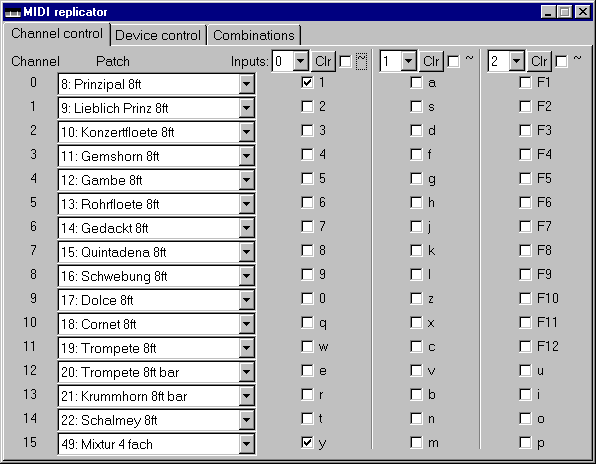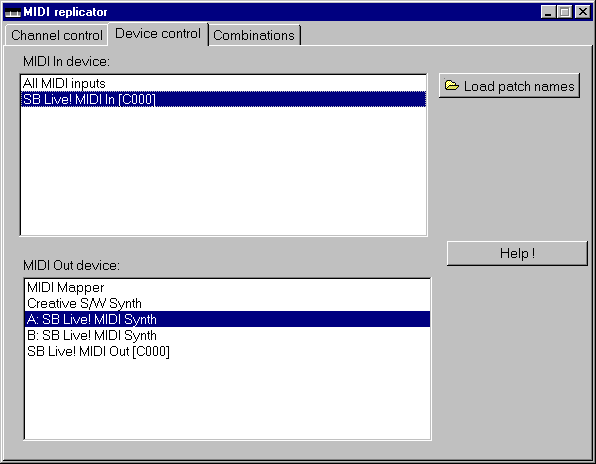Russian text
MIDI Replicator
OS: Windows 9x/ME. Not tested under NT.
Distribution: Freeware.
Purpose: MIDI Replicator is intended for redirection of MIDI events, which come in
some three channels from MIDI input devices (keyboards), to any number of 16 output channels of
MIDI output device (synthesizer). Either one or all registered MIDI inputs can be used. The
Replicator always uses one MIDI output.
System requirements: At least one soundcard should be installed (MIDI input and
MIDI output should be present in the system).
Installation: Create a directory and copy contents of the archive there. Make a shortcut
to midirepl.exe program on the Windows Desktop in case of need. The program does not require to
make additional changes in Windows setup, and it does not write anything to system directories or
Registry.
Download MIDI.ZIP
(~177Kb)
The main area of application of the Replicator is emulation of pipe organ on a PC. As is well
known, pipe organ is an instrument which sound is usually reproduced by synthesizers absolutely
unsatisfactorily. One of causes of this is tremendous variety of timbres which are obtained during
combined sounding of several registers of organ. Even if organ has only 10 registers (more then
hundred may it have) then it is possible to make 1023 different combinations of them. Not all that
combinations will produce harmonious sound, but the fact is: synthesizer must have large quantity
of samples of timbres for particular combinations of registers. Legal desire occurs - to use lesser
amount of timbres, namely - to put to synthesizer the timbres of single registers only, and
simultaneously generate sound of many single registers for any reproduced note. Replicator does do
it.
MIDI Replicator supports three input channels (it is enough for two manuals and pedal). MIDI
devices should be connected either to one input port (of one soundcard) or to input ports of
particular soundcards installed for each keyboard. In the first case, either additional MIDI-
concentrator device required (expensive thing) or MIDI keyboard must have MIDI-THRU input (far
from all models have it). In the second case, incompatibility of soundcards may lead to various
conflicts.
Logical MIDI-channels, in which events from MIDI devices come in, should be different to
allow different timbres for notes which are played on different keyboards. MIDI keyboards of
allmost any types, except of most primitive ones, allow to set up MIDI channel.
Controls on "Channel control" page
 The Replicator
allows to combine 16 of 128 available timbres simultaneously (128 is a number of output channels
available). Timbres' names for all output channels are displayed in "patch" column. This column
consists of combo-boxes; which give a possibility to set up timbre of any output channels at any
time. In order to see patch names rather than patch numbers in the combo-boxes, the patch names
should be loaded from previously created .PTC file. Format of .PTC file complies with .INI file
format specification. The example - patches.ptc - is included. Timbres in this sample file describe
the pipe organ soundfont from Andreas Sims:
The Replicator
allows to combine 16 of 128 available timbres simultaneously (128 is a number of output channels
available). Timbres' names for all output channels are displayed in "patch" column. This column
consists of combo-boxes; which give a possibility to set up timbre of any output channels at any
time. In order to see patch names rather than patch numbers in the combo-boxes, the patch names
should be loaded from previously created .PTC file. Format of .PTC file complies with .INI file
format specification. The example - patches.ptc - is included. Timbres in this sample file describe
the pipe organ soundfont from Andreas Sims:
http://home.t-online.de/home/andreas.sims/index.htm.
Input channels for up to three keyboards should be assigned using three combo-boxes in the
upper row of the page.
All note on/off events of input channel (as well as other events) will be redirected to those
output channels which have a checkmark in a checkbox on the intersection of input channel column
and output channel row. Checkmark may be set up or cleaned with mouse, or Space key, or using
hot key which is displayed right of the checkbox. Since a pipe organ is insensitive to key press
force, then velocity value of each incoming note-on event is set up to the fixed value of 90 forcedly
before sending to output channel.
"Clr" ("Clear") and "~" ("Tremulant") buttons are located near output channel combo-boxes.
With "Clr" button it is possible to clear all output channel marks of corresponding input channel,
giving the possibility to set up a new timbre combination "from zero". "~" checkbox allows to
modulate sound of input channel, like Tremulant effect of pipe organ.
It is necessary to take in view the following while using Tremulant:
1. Modulation is applied to all output channels which correspond to input channels with
Tremulant on. If the output channel is used for multiple inputs, and one of these inputs has
Tremulant on, then modulation will be used in this output for all input events in any connected
inputs, including inputs with Tremulant off.
2. Any modulation wheel in the system (on any keyboard, including ones with Tremulant off)
may be used to change effect value. This adjustment take effect all over the system, i.e. for all input
channels with Tremulant applied.
3. The Replicator changes soundcard programming during startup, sending some MIDI
controllers to set up lower modulation frequency than default. This MIDI command sequence may
be not supported by particular soundcard (the program is tested on SB Live!), but to all appearance
it should not corrupt anything. The sequence is (where x is a channel number):
9xh-99-127, 9xh-98-1, 9xh-6-64, 9xh-38-54
All settings of this page are stored in midirepl.ini file in the program startup directory. These
parameters will be automatically loaded on next program start.
Controls on "Device control" page
 On this page you
can choose input and output MIDI devices from the list of registered MIDI devices.
On this page you
can choose input and output MIDI devices from the list of registered MIDI devices.
Input device is that soundcard to which keyboards are connected. If several soundcards are used
for several keyboards then you should select "All MIDI inputs".
Output device is either soundcard or external synthesizer producing sound. On selection "MIDI
Mapper" the default Windows MIDI output will be selected.
"Load patch names" button allows to load the names of timbres (registers) and their mapping
into MIDI instrument numbers from a file with .PTC extension. This format coincides with .INI file
format and is intuitively understandable; the file can be created/edited with any text editor program.
An example - patches.ptc file - comes with the program. Edit this file and save it with another name
to create your own set of register names.
All settings of this page, including loaded timbre names, are stored in midirepl.ini file in the
program startup directory. These parameters will be automatically loaded on next program
start.
Controls on "Combinations" page
 The Replicator
allows to create up to 12 register combinations which can be activated during performance with
Ctrl-F1 - Ctrl-F12 key combinations as well as with selection in the list of combinations on this
page. Register combination includes information about state of all controls on the first page
("Channel control"), i.e. what timbres for what outputs are used and in what output channels are
input channels redirected. Tremulant settings are also included.
The Replicator
allows to create up to 12 register combinations which can be activated during performance with
Ctrl-F1 - Ctrl-F12 key combinations as well as with selection in the list of combinations on this
page. Register combination includes information about state of all controls on the first page
("Channel control"), i.e. what timbres for what outputs are used and in what output channels are
input channels redirected. Tremulant settings are also included.
"Gray Plus" and "Gray Minus" keys allows to select and use the next and the previous filled cell
in the combinations list.
To fast store the current register combination (the combination in use) press Ctrl-S keys. The
action of this combination is duplicated by "Add current" button. User will be prompted to enter the
name of the combination. The combination will occupy the firs free cell. There is no way to change
the order of combinations in combinations list in this version.
"Delete" button allows to clear selected cell in combinations list. "Clear all" button clears all 12
cells.
The list of combinations can be stored in a file with .RGS extension and loaded from such a file
afterwards. The list is also stored in midirepl.ini file in the program startup directory and will be
automatically loaded on next program start.
 The Replicator
allows to combine 16 of 128 available timbres simultaneously (128 is a number of output channels
available). Timbres' names for all output channels are displayed in "patch" column. This column
consists of combo-boxes; which give a possibility to set up timbre of any output channels at any
time. In order to see patch names rather than patch numbers in the combo-boxes, the patch names
should be loaded from previously created .PTC file. Format of .PTC file complies with .INI file
format specification. The example - patches.ptc - is included. Timbres in this sample file describe
the pipe organ soundfont from Andreas Sims:
The Replicator
allows to combine 16 of 128 available timbres simultaneously (128 is a number of output channels
available). Timbres' names for all output channels are displayed in "patch" column. This column
consists of combo-boxes; which give a possibility to set up timbre of any output channels at any
time. In order to see patch names rather than patch numbers in the combo-boxes, the patch names
should be loaded from previously created .PTC file. Format of .PTC file complies with .INI file
format specification. The example - patches.ptc - is included. Timbres in this sample file describe
the pipe organ soundfont from Andreas Sims: On this page you
can choose input and output MIDI devices from the list of registered MIDI devices.
On this page you
can choose input and output MIDI devices from the list of registered MIDI devices. The Replicator
allows to create up to 12 register combinations which can be activated during performance with
Ctrl-F1 - Ctrl-F12 key combinations as well as with selection in the list of combinations on this
page. Register combination includes information about state of all controls on the first page
("Channel control"), i.e. what timbres for what outputs are used and in what output channels are
input channels redirected. Tremulant settings are also included.
The Replicator
allows to create up to 12 register combinations which can be activated during performance with
Ctrl-F1 - Ctrl-F12 key combinations as well as with selection in the list of combinations on this
page. Register combination includes information about state of all controls on the first page
("Channel control"), i.e. what timbres for what outputs are used and in what output channels are
input channels redirected. Tremulant settings are also included.